Digital Posters
Developments in RF Components
ISMRM & SMRT Annual Meeting • 15-20 May 2021

| Concurrent 2 | 17:00 - 18:00 |
1391.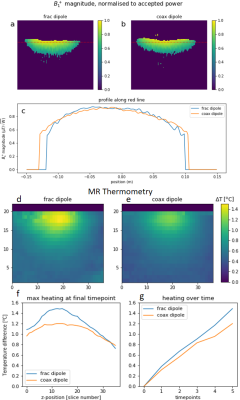 |
The Coax Dipole Antenna: a flexible, low SAR dipole antenna for body imaging at 7 Tesla.
Carel C. van Leeuwen1, Bart R.E. Steensma1, Dennis W.J. Klomp1, Cornelis A.T. van den Berg1, and Alexander J.E. Raaijmakers1,2
1University Medical Center Utrecht, Utrecht, Netherlands, 2Biomedical Engineering, Eindhoven University of Technology, Eindhoven, Netherlands
A coax cable dipole antenna with gaps in the shield supports flat current profiles on the outside of the shield. A simulation study is performed to further optimize the design of this flexible so-called ‘coax dipole antenna’. MR thermometry measurements are performed using a single antenna and a homogeneous phantom. The coax dipole antenna causes 18% lower peak heating than a fractionated dipole antenna. An array of eight coax dipole antennas is used to generate T2-weighted images and B1 maps of the prostate of three volunteers, where the coax dipoles achieve the same B1 as an array of fractionated dipoles.
|
|||
1392.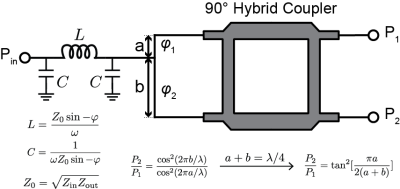 |
Bailey splitter/combiner for RF shimming/Rx coil combination
Yue Zhu1,2, John C Gore1,2,3,4, and Xinqiang Yan1,2
1Vanderbilt University Institute of Imaging Science, Nashville, TN, United States, 2Department of Radiology and Radiological Sciences, Vanderbilt University, Nashville, TN, United States, 3Biomedical Engineering, Vanderbilt University, Nashville, TN, United States, 4Electrical and Computer Engineering, Vanderbilt University, Nashville, TN, United States
We designed a continuously adjustable Bailey splitter/combiner with a sliding mechanism. This device has a good input matching of < -18dB and a low insertion loss of about -0.5dB. The sliding mechanism allowed easy handling and precise adjustments. The resistor free design eliminated the potential safety concern from the previous Ratio Adjustable Power Splitter circuits. We obtained good agreements between predicted and measured transmit field maps with the Bailey splitter/combiner.
|
|||
1393.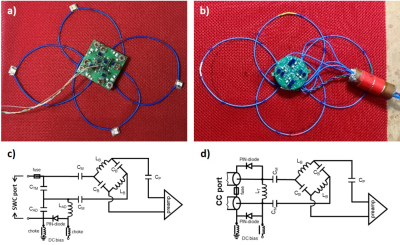 |
Performance of flexible coaxial transmission line resonator coils vs. stranded wire coils at 3 T
Raphaela Czerny1, Michael Obermann1, and Elmar Laistler1
1High Field MR Center, Center for Medical Physics and Biomedical Engineering, Medical University of Vienna, Vienna, Austria
As flexible form-fitting RF coils can provide enhanced receive sensitivity in MRI, various coil design approaches have been studied recently, including coaxial and stranded wire coil elements. While stranded wire coils are electrically identical to conventional rigid copper loop coils, coaxial transmission line resonators are self-resonant and do not require additional components along the conductor. The goal of this work was to compare flexible receive-only stranded wire coils and coaxial coils in terms of Q-factors, inter-element coupling, noise correlation, and SNR.
|
|||
1394. |
High Impedance Loop coil Design for improved EM Decoupling in Multichannel Coil arrays
Sirihaas Gaddipati1 and Xiaoliang zhang2
1University at Buffalo, Buffalo, NY, United States, 2Biomedical Engineering, University at Buffalo, Buffalo, NY, United States
In traditional magnetic resonance imaging (MRI) design, ideal coil overlapping is used to minimize coupling between nearest-neighbor coils, and low input impedance preamplifiers are used to isolate the relatively weak coupling. Modern-day MR systems use phased array coils constructed out of low impedance resonant loops. Inside such arrays, electrodynamic interactions between elements must be carefully balanced[1]. However, to make the complex sensitivities of phased-array coils sufficiently distinct in parallel spatially-encoded MRI, needed an overlapping between coils. This electromechanical balancing act becomes increasingly difficult as the number of receive elements grows for optimal performance, leading to geometrical puzzles of profound complexity.
|
|||
1395.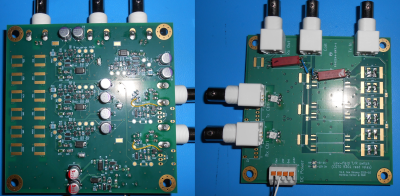 |
An Improved Power Handling Active Transmit/Receive Switch for Low Field MRI using Reed Relays
Don Straney1, Clarissa Zimmerman Cooley1,2, and Matthew S Rosen1,2,3
1Athinoula A. Martinos Center for Biomedical Imaging, Massachusetts General Hospital, Charlestown, MA, United States, 2Harvard Medical School, Boston, MA, United States, 3Department of Physics, Harvard University, Cambridge, MA, United States
An active transmit/receive (T/R) switch based on reed relays shows promise in overcoming the previous limitations at low field of both passive and active T/R switches. We aim to provide a design for other low-field researchers to use which handles a wide range of frequencies (DC to 3.4 Mhz) and power levels (<1 mW to 2 kW pulsed) in a simple, low-parts-count device which is easy to reproduce.
|
|||
1396.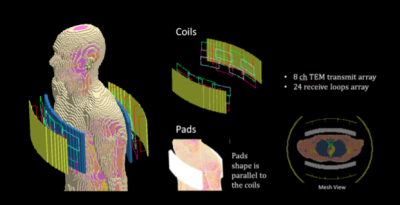 |
Use of High - Permittivity Pads to enhance SNR and Transmit Efficiency in the Chest at 7T
Giuseppe Carluccio1,2 and Christopher Michael Collins1,3
1Radiology, Center for Advanced Imaging Innovation and Research (CAI2R), New York, NY, United States, 2Radiology, Bernard and Irene Schwartz Center for Biomedical Imaging, New York, NY, United States, 3Bernard and Irene Schwartz Center for Biomedical Imaging, New York, NY, United States
High-Permittivity materials have been recently used to shape the B1 field distribution to enhance SNR and transmit efficiency. So far, these materials have been mainly applied to increase SNR in the head. In this work, through numerical simulations, we explore the possibility to use high-permittivity pads to improve the signal in the chest. The pads are positioned between the model of the coils (8 TEM transmit coils and 24 receive loops) and of the human body. Our simulations show that some improvement can be obtained by adding the pads to the coils.
|
|||
1397.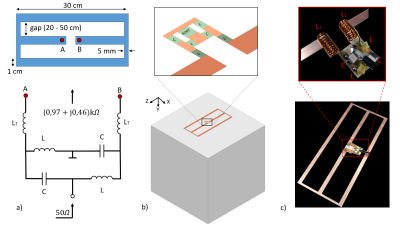 |
Introducing the Double-Folded Dipole to enhance the Excitation Efficiency at 7T Ultra-High Field MRI
Sam-Luca J.D. Hansen1, Markus W. May1, Mirsad Mahmutovic1, Manisha Shrestha1, Anpreet Ghotra1, Matthäus Poniatowski1, and Boris Keil1
1Institute of Medical Physics and Radiation Protection, TH Mittelhessen University of Applied Sciences, Gießen, Germany
We demonstrated a highly efficient B1+to-SAR dipole antenna for ultrahigh-field MRI which consists of a double-folded ladder structure. The antenna was simulated and bench tested. The antenna has a high impedance which provides low mutual coupling between other antenna elements. Ultimately, this characteristic possibly allows to construct antenna array for pTx.
|
|||
1398.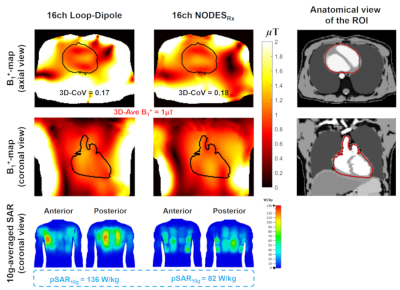 |
Non-Uniform Dielectric Substrate (NODES) Antenna Design for Cardiac Imaging at 7T
Alireza Sadeghi-Tarakameh1, Bahram Khalichi2, Xiaoping Wu1, Gregory J. Metzger1, and Yigitcan Eryaman3
1Center for Magnetic Resonance Research (CMRR), University of Minnesota, Minneapolis, MN, United States, 2Department of Electrical and Electronics Engineering, Bilkent University, Ankara, Turkey, 3University of Minnesota, Minneapolis, MN, United States
Utilizing receive and transmit array coils with improved SNR/SAR performance is crucial to realizing the full potential of ultra-high field (UHF) MRI. In this work, we optimize a previously introduced antenna (NODES) to improve its SNR and SAR performances for 7T cardiac MRI applications.
|
|||
1399.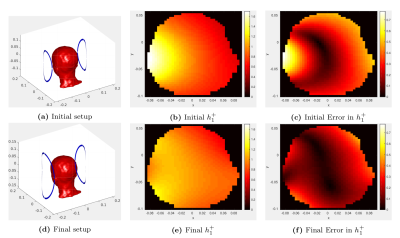 |
Parametric Coil Optimization via Global Optimization
Jose EC Serralles1, Elfar Adalsteinsson2,3, Lawrence L Wald4, and Luca Daniel1
1Computational Prototyping Group (CPG), Research Laboratory of Electronics (RLE), Department of Electrical Engineering and Computer Science (EECS), Massachusetts Institute of Technology (MIT), Cambridge, MA, United States, 2Department of Electrical Engineering and Computer Science (EECS), Massachusetts Institute of Technology (MIT), Cambridge, MA, United States, 3Institute for Medical Engineering and Science (IMES), Massachusetts Institute of Technology (MIT), Cambridge, MA, United States, 4Martinos Center for Biomedical Imaging, Massachusetts General Hospital, Harvard Medical School, Boston, MA, United States
Algorithmic design of coil arrays in MRI is typically considered desirable but computationally intractable. In this work, we demonstrate that it is in fact feasible to programmatically optimize over the design of a coil array to achieve a metric-of-interest, such as slice homogeneity in the transmit field. We build on previous work by employing global optimizers in several of the key steps in the optimization procedure. We demonstrate the effectiveness of this approach via a couple of numerical examples.
|
|||
1400. |
MR imaging with a standard electro-optical modulator: Initial results
Paul Nobre1, Gwenaël Gaborit2,3, Raphaël Sablong1, Lionel Duvillaret3, and Olivier Beuf1
1Univ. Lyon, INSA-Lyon, Université Lyon 1, UJM-Saint Etienne, CNRS, Inserm, CREATIS, UMR 5220, U1206, Villeurbanne, France, 2Université de Savoie, IMEP-LAHC, UMR 5130, Le Bourget-du-Lac, France, 3KAPTEOS, Sainte-Hélène-du-Lac, France
The large majority of receiver clinical MR coil are using cables between the resonant coil and Connector plug. To remove possible induced currents on the cable’s shield, circuits such as RF traps are distributed along the cable. This is done to ensure patients’ safety during the exam. RF-traps are difficult to miniaturize and are not fit for inner coils such as endoluminal coils. Optical fibers would be a smart option to get rid of this critical drawback but this requires electro-optical conversion devices. This abstract presents the first images obtained at 7T with an electro-optical conversion based on Pockel’s effect.
|
|||
1401. |
Correcting meander-line surface coil fields for large-area near-surface imaging
Gary Zabow1, Stephen Dodd2, and Alan Koretsky2
1Applied Physics Division, National Institute of Standards and Technology (NIST), Boulder, CO, United States, 2NINDS, National Institutes of Health (NIH), Bethesda, MD, United States
Planar meander-line coils have been proposed as ideal surface coils because they should, theoretically, create highly uniform fields over planes of essentially unlimited area. Experimentally, however, field uniformity of planar meander-line coils is often worse, not better, than even simple loop surface coils. This presentation shows why existing predictions of meander-line coil fields and imaging performance are misinterpreted and how coil geometries can be simply corrected to better match theory. In particular, it is shown how a single extra turn of wire can increase field uniformity by at least an order of magnitude, allowing for uniform, large-area near-surface imaging.
|
|||
1402. |
UVC Based Wireless Patient Bore Disinfection Utilizing Scanner RF Transmission
Devavrat Likhite1, Rob Amerling1, Leon Lee1, and Saban Kurucay1
1GE Healthcare, Waukesha, WI, United States
In the recent times, cleaning protocols after every patient, regular disinfection of medical equipment and use of single-use devices have become a common practice. MRI equipment has been one of the most difficult imaging modalities to clean. Here, we present a simple technique that uses UV light to disinfect the MRI system, without the use of any external power or connecting cables. This technique uses the power from the MRI system and thereby provides a simple and wire-free UV disinfection solution that does not need external electrical source.
|
|||
1403.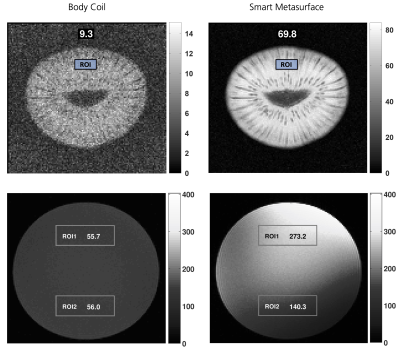 |
Smart Metamaterials for 3T MRI
Dennis Philipp1, Endri Stoja2, Simon Konstandin1, Robin Wilke1, Diego Betancourt2, Thomas Bertuch2, Juergen Jenne1,3, Reiner Umathum1,3, and Matthias Guenther1,4
1Fraunhofer MEVIS, Bremen, Germany, 2Fraunhofer FHR, Wachtberg, Germany, 3German Cancer Research Center DKFZ, Heidelberg, Germany, 4MR Imaging and Spectroscopy, Faculty 01, University of Bremen, Bremen, Germany
Smart metasurfaces, special two-dimensional metamaterial devices, have a huge potential to drastically improve imaging efficiency in MRI and are a promising tool to overcome some of the limitations which are hampering technological advances in the field. The design, simulation, and experimental verification of thin, smart, non-linear metasurfaces is presented, which yield an up to eightfold enhanced signal-to-noise ratio in 3T MRI. The smart metasurface is a system of two inductively coupled structures, one of which has a non-linear, incident power-dependent behavior. On-bench characterization and MRI scans with a homogeneous phantom and a kiwi fruit prove the functionality and working principle.
|
|||
1404. |
High dielectric sheet to reduce electric fields in Self-decoupled radiofrequency coils for magnetic resonance imaging
Aditya Ashok Bhosale1 and Xiaoliang Zhang1
1Biomedical Engineering, State University of New York, Buffalo, Buffalo, NY, United States
Self-decoupled radiofrequency coils reduce the electromagnetic coupling between the coil elements and eliminate the use of complex decoupling technologies. The use of a small value capacitor (Cmode) in a self-decoupled coil helps in eliminating the coupling between coil elements but causes a large electric field across the Cmode capacitor1.which may potentially cause a safety problem during imaging. In this study, we propose the use of a high dielectric sheet to reduce the electric field across the capacitor and thereby reducing the higher SAR in the subject.
|
|||
1405.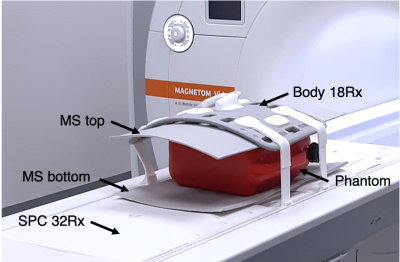 |
Lightweight metasurface pads for passive RF shimming in 3T abdominal imaging
Tania del Socorro Vergara Gomez1,2, Marc Dubois1,2,3, Pierre Jomin2, Megdouda Benamara3, Djamel Berrahou3, Elodie Georget3, Tryfon Antonakakis3, David Bendahan1, Frank Kober1, Stefan Enoch2, and Redha Abdeddaim2
1Aix Marseille Univ, CNRS, CRMBM, Marseille, France, 2Aix Marseille Univ, CNRS, Centrale Marseille, Institut Fresnel, Marseille, France, 3Multiwave Imaging, Marseille, France
Abdominal imaging at 3T suffers from B1+ inhomogeneities due to radiofrequency (RF) wavelength reduction. High permittivity dielectric pads have been introduced as suitable solution to this problem. Such pads can require up to a few kilograms of ceramic powder usually dispersed in water. This could be detrimental to patient comfort during examination. Here we present a new approach based on thin, lightweight and flexible metasurface pads. The pads are shown to improve transmit and receive efficiency together with SNR in vitro.
|
|||
1406.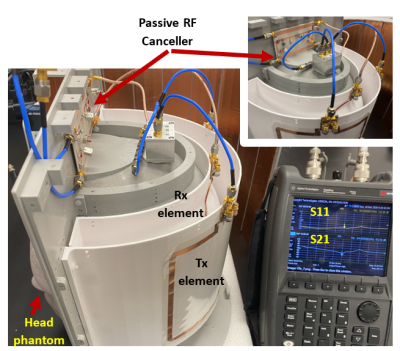 |
Passive Tunable RF Leakage Canceller for Simultaneous Transmit and Receive (STAR) RF Coils at 1.5T Imaging
Zachary Colwell1, Djaudat Idiyatullin2, Lance DelaBarre2, Thomas Vaughan3, Michael Garwood2, and Sung-Min Sohn1
1School of Biological and Health Systems Engineering, Arizona State University, Tempe, AZ, United States, 2Center for Magnetic Resonance Research, Department of Radiology, University of Minnesota, Minneapolis, MN, United States, 3Zuckerman Institute, Columbia University, New York, NY, United States
Simultaneous Transmit and Receive (STAR) requires high decoupling between the RF transmitter and receiver. Current methods for this include, but are not limited to: geometric isolation, active RF leakage cancellation and metamaterial decoupling. The presented method uses a passive, four-port, tunable canceller circuit to achieve upwards of 40 dB of isolation between a quadrature transmit coil pair and the single receiving coil for a 1.5T system.
|
|||
1407.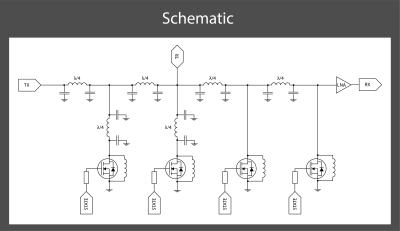 |
Gallium nitride MOSFETs enable transmit-receive switching in less than 100ns
Christoph Michael Schildknecht1, Markus Weiger1, Romain Froidevaux1, and Klaas Paul Pruessmann1
1Institute for Biomedical Engineering, ETH Zurich and University of Zurich, Zürich, Switzerland
For short-T2 MRI measurements, fast T/R switches that can handle high RF power are of paramount importance. In this work, we present a T/R switch based on GaN MOSFETs that switches in tens of nanoseconds and can handle a peak power of more than 1000W.
|
|||
1408.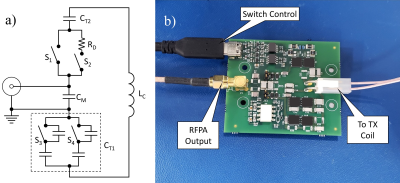 |
Galvanically Isolated RF Switches for Low Field MRI
Mike Twieg1
1Hyperfine Research, Guilford, CT, United States
RF switches occupy many roles in MRI RF systems, including spoiling, damping, transmit/receive (T/R) switches, digital tuners, and crossbar switches. For high field MRI, PIN diodes are the switching device of choice, but at low field strength FETs are attractive. However, implementing the typical drive circuitry for the switch is difficult at lower frequencies. Here we describe a novel drive circuit suitable for a broad frequency range. It does not rely on any ferrous materials, or any high frequency oscillating circuits, and is thus suitable for use on the coil.
|
|||
1409.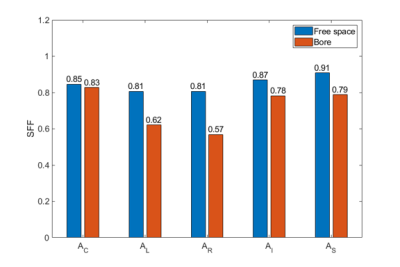 |
UWB antenna system fidelity investigation for wireless MRI
Wonje Lee1, Fraser Robb2, John Pauly3, Shreyas Vasanawala1, and Greig Scott3
1Pediatric Radiology, Stanford University, Palo Alto, CA, United States, 2GE Healthcare, Aurora, OH, United States, 3Electrical Engineering, Stanford University, Palo Alto, CA, United States
We assess the effect of UWB antenna arrangement within a simulated bore environment that includes a pediatric human phantom using system fidelity factor calculations for wireless data link integrity
|
|||
1410.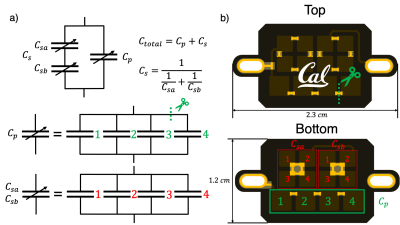 |
Flexible Tunable Capacitor: A Variable Capacitor for Tuning Flexible/Thermoformed MRI Coils
Julian Adolfo Maravilla1, Karthik Gopalan1, Ana Claudia Arias1, and Michael Lustig1
1EECS, UC Berkeley, Berkeley, CA, United States
Recent advances in coil design and fabrication have allowed for flexible and thermoformed coil arrays. However, the weak solder joints and rigid design of traditional variable capacitors used with these coils greatly limit their flexibility. Here, we propose the Flexible Tunable Capacitor (FTC), a high-Q, flexible, easily tunable variable capacitor. This design uses an array of small low-loss parallel plate capacitors adjustable with small step sizes by exploiting series and parallel combinations. This work proposes a basic design that offers a wide range of capacitor values (0.5 pF to 7 pF) suitable for 3T and 7T coils.
|
The International Society for Magnetic Resonance in Medicine is accredited by the Accreditation Council for Continuing Medical Education to provide continuing medical education for physicians.